Comprehensive Report on BEMS Implementation for VAV Systems
VerifiedAdded on 2020/04/15
|24
|5946
|68
Report
AI Summary
This report delves into the application of Building Energy Management Systems (BEMS) within Variable Air Volume (VAV) systems, a critical component of HVAC systems in modern buildings. The report begins with an introduction to VAV systems and their operational principles, contrasting them with Constant Air Volume (CAV) systems. It then explores the technical aspects of BEMS, highlighting their role in monitoring and controlling building equipment to optimize energy consumption. The advantages of BEMS, such as enhanced energy efficiency and improved environmental conditions, are detailed, alongside their disadvantages, including higher initial costs and maintenance requirements. The report further discusses green building design principles and their contribution to reducing carbon emissions, emphasizing the importance of energy recovery, energy substitution, and energy conservation. It also examines space and work efficiency considerations, highlighting how BEMS can optimize building resource utilization. Finally, the report addresses the impact of BEMS on occupant comfort and provides a comparison of energy saving and carbon emissions between VAV and CAV systems, concluding with a summary of the key findings and implications of BEMS implementation in VAV systems.
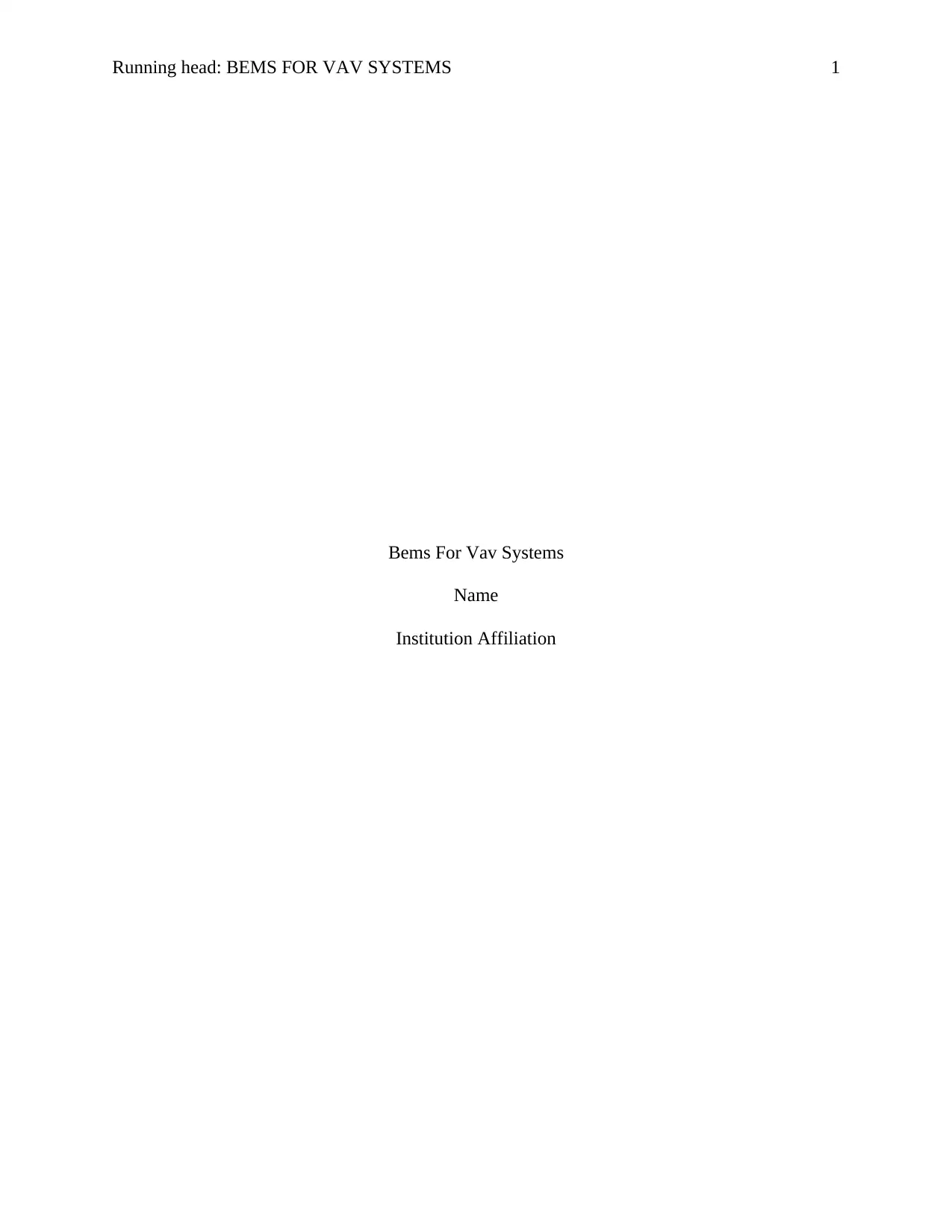
Running head: BEMS FOR VAV SYSTEMS 1
Bems For Vav Systems
Name
Institution Affiliation
Bems For Vav Systems
Name
Institution Affiliation
Paraphrase This Document
Need a fresh take? Get an instant paraphrase of this document with our AI Paraphraser
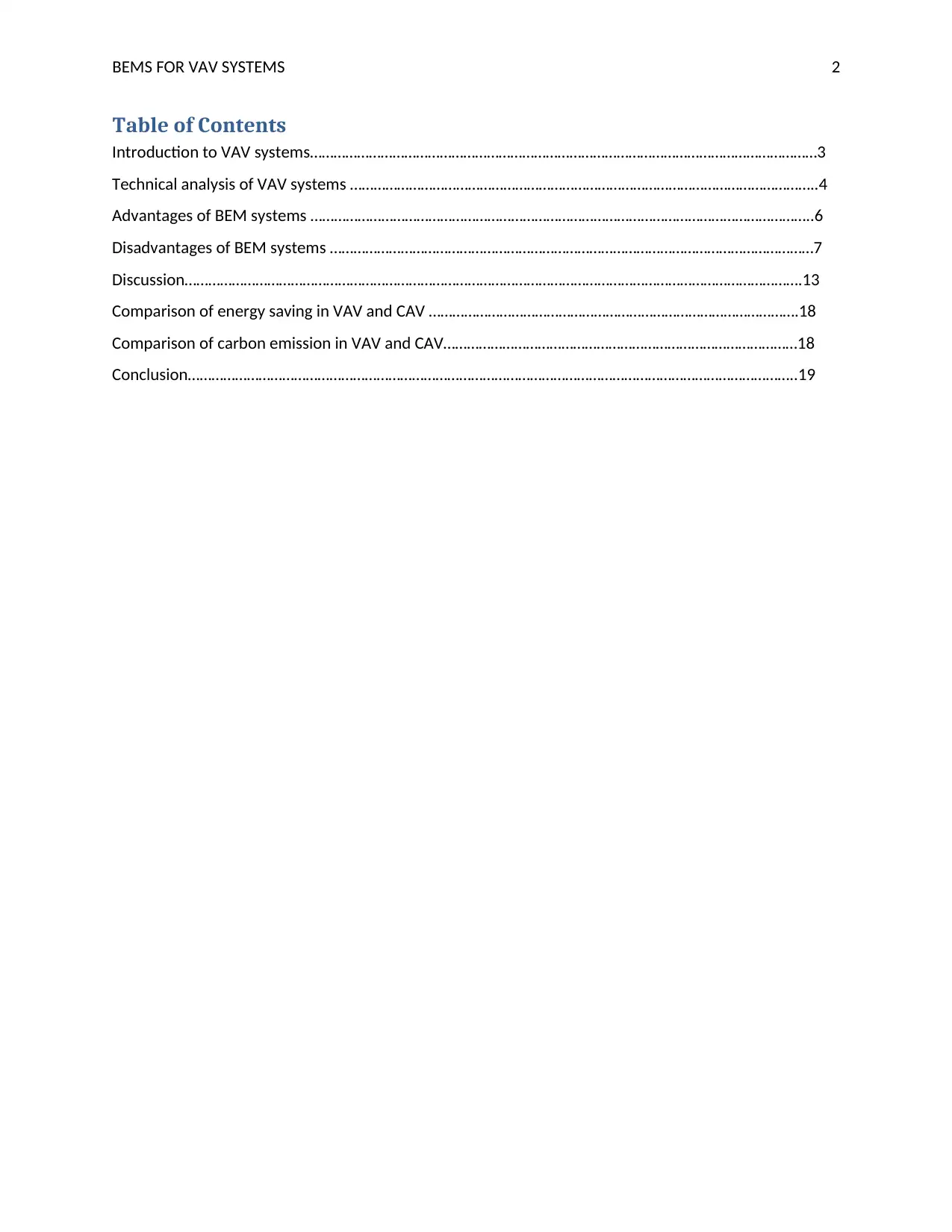
BEMS FOR VAV SYSTEMS 2
Table of Contents
Introduction to VAV systems…………………………………………………………………………………………………………………3
Technical analysis of VAV systems ………………………………………………………………………………………………………..4
Advantages of BEM systems ………………………………………………………………………………………………………………..6
Disadvantages of BEM systems ……………………………………………………………………………………………………………7
Discussion………………………………………………………………………………………………………………………………………….13
Comparison of energy saving in VAV and CAV ………………………………………………………………………………….18
Comparison of carbon emission in VAV and CAV………………………………………………………………………………18
Conclusion………………………………………………………………………………………………………………………………………..19
Table of Contents
Introduction to VAV systems…………………………………………………………………………………………………………………3
Technical analysis of VAV systems ………………………………………………………………………………………………………..4
Advantages of BEM systems ………………………………………………………………………………………………………………..6
Disadvantages of BEM systems ……………………………………………………………………………………………………………7
Discussion………………………………………………………………………………………………………………………………………….13
Comparison of energy saving in VAV and CAV ………………………………………………………………………………….18
Comparison of carbon emission in VAV and CAV………………………………………………………………………………18
Conclusion………………………………………………………………………………………………………………………………………..19
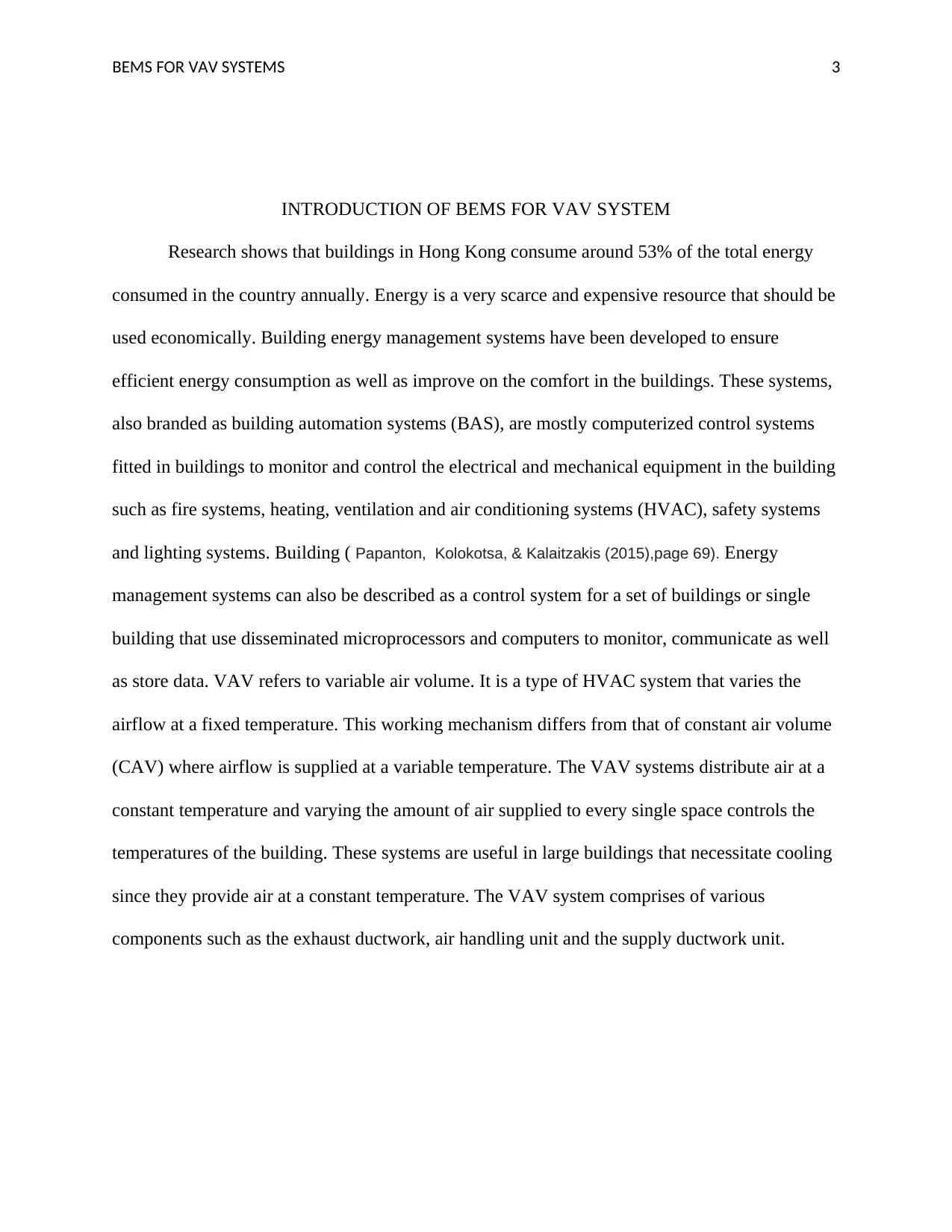
BEMS FOR VAV SYSTEMS 3
INTRODUCTION OF BEMS FOR VAV SYSTEM
Research shows that buildings in Hong Kong consume around 53% of the total energy
consumed in the country annually. Energy is a very scarce and expensive resource that should be
used economically. Building energy management systems have been developed to ensure
efficient energy consumption as well as improve on the comfort in the buildings. These systems,
also branded as building automation systems (BAS), are mostly computerized control systems
fitted in buildings to monitor and control the electrical and mechanical equipment in the building
such as fire systems, heating, ventilation and air conditioning systems (HVAC), safety systems
and lighting systems. Building ( Papanton, Kolokotsa, & Kalaitzakis (2015),page 69). Energy
management systems can also be described as a control system for a set of buildings or single
building that use disseminated microprocessors and computers to monitor, communicate as well
as store data. VAV refers to variable air volume. It is a type of HVAC system that varies the
airflow at a fixed temperature. This working mechanism differs from that of constant air volume
(CAV) where airflow is supplied at a variable temperature. The VAV systems distribute air at a
constant temperature and varying the amount of air supplied to every single space controls the
temperatures of the building. These systems are useful in large buildings that necessitate cooling
since they provide air at a constant temperature. The VAV system comprises of various
components such as the exhaust ductwork, air handling unit and the supply ductwork unit.
INTRODUCTION OF BEMS FOR VAV SYSTEM
Research shows that buildings in Hong Kong consume around 53% of the total energy
consumed in the country annually. Energy is a very scarce and expensive resource that should be
used economically. Building energy management systems have been developed to ensure
efficient energy consumption as well as improve on the comfort in the buildings. These systems,
also branded as building automation systems (BAS), are mostly computerized control systems
fitted in buildings to monitor and control the electrical and mechanical equipment in the building
such as fire systems, heating, ventilation and air conditioning systems (HVAC), safety systems
and lighting systems. Building ( Papanton, Kolokotsa, & Kalaitzakis (2015),page 69). Energy
management systems can also be described as a control system for a set of buildings or single
building that use disseminated microprocessors and computers to monitor, communicate as well
as store data. VAV refers to variable air volume. It is a type of HVAC system that varies the
airflow at a fixed temperature. This working mechanism differs from that of constant air volume
(CAV) where airflow is supplied at a variable temperature. The VAV systems distribute air at a
constant temperature and varying the amount of air supplied to every single space controls the
temperatures of the building. These systems are useful in large buildings that necessitate cooling
since they provide air at a constant temperature. The VAV system comprises of various
components such as the exhaust ductwork, air handling unit and the supply ductwork unit.
⊘ This is a preview!⊘
Do you want full access?
Subscribe today to unlock all pages.

Trusted by 1+ million students worldwide
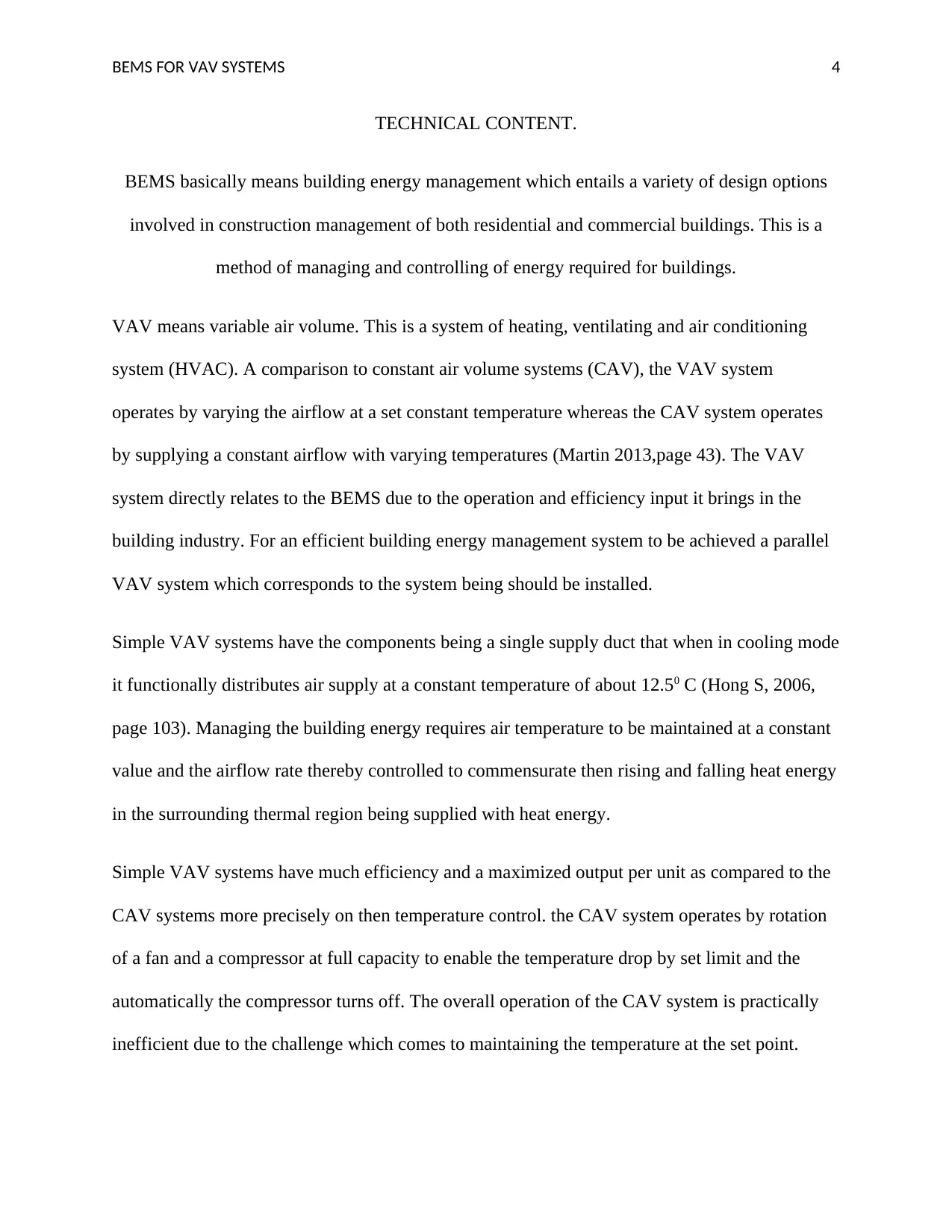
BEMS FOR VAV SYSTEMS 4
TECHNICAL CONTENT.
BEMS basically means building energy management which entails a variety of design options
involved in construction management of both residential and commercial buildings. This is a
method of managing and controlling of energy required for buildings.
VAV means variable air volume. This is a system of heating, ventilating and air conditioning
system (HVAC). A comparison to constant air volume systems (CAV), the VAV system
operates by varying the airflow at a set constant temperature whereas the CAV system operates
by supplying a constant airflow with varying temperatures (Martin 2013,page 43). The VAV
system directly relates to the BEMS due to the operation and efficiency input it brings in the
building industry. For an efficient building energy management system to be achieved a parallel
VAV system which corresponds to the system being should be installed.
Simple VAV systems have the components being a single supply duct that when in cooling mode
it functionally distributes air supply at a constant temperature of about 12.50 C (Hong S, 2006,
page 103). Managing the building energy requires air temperature to be maintained at a constant
value and the airflow rate thereby controlled to commensurate then rising and falling heat energy
in the surrounding thermal region being supplied with heat energy.
Simple VAV systems have much efficiency and a maximized output per unit as compared to the
CAV systems more precisely on then temperature control. the CAV system operates by rotation
of a fan and a compressor at full capacity to enable the temperature drop by set limit and the
automatically the compressor turns off. The overall operation of the CAV system is practically
inefficient due to the challenge which comes to maintaining the temperature at the set point.
TECHNICAL CONTENT.
BEMS basically means building energy management which entails a variety of design options
involved in construction management of both residential and commercial buildings. This is a
method of managing and controlling of energy required for buildings.
VAV means variable air volume. This is a system of heating, ventilating and air conditioning
system (HVAC). A comparison to constant air volume systems (CAV), the VAV system
operates by varying the airflow at a set constant temperature whereas the CAV system operates
by supplying a constant airflow with varying temperatures (Martin 2013,page 43). The VAV
system directly relates to the BEMS due to the operation and efficiency input it brings in the
building industry. For an efficient building energy management system to be achieved a parallel
VAV system which corresponds to the system being should be installed.
Simple VAV systems have the components being a single supply duct that when in cooling mode
it functionally distributes air supply at a constant temperature of about 12.50 C (Hong S, 2006,
page 103). Managing the building energy requires air temperature to be maintained at a constant
value and the airflow rate thereby controlled to commensurate then rising and falling heat energy
in the surrounding thermal region being supplied with heat energy.
Simple VAV systems have much efficiency and a maximized output per unit as compared to the
CAV systems more precisely on then temperature control. the CAV system operates by rotation
of a fan and a compressor at full capacity to enable the temperature drop by set limit and the
automatically the compressor turns off. The overall operation of the CAV system is practically
inefficient due to the challenge which comes to maintaining the temperature at the set point.
Paraphrase This Document
Need a fresh take? Get an instant paraphrase of this document with our AI Paraphraser

BEMS FOR VAV SYSTEMS 5
Building energy management is a key aspect which considers majorly the quantitative and
qualitative energy management in buildings. Simple VAV systems have an advantage of
conserving energy thereby increased energy savings. The fans control system is composed of
electronic variable speed-drives thus reducing the amount of energy consumed and this has a
general impact on the total cooling energy required for a specified building.
VAV system has a substantially increased dehumidification due to reduced airflow thus air is
cooled for a longer period of time and more air moisture condenses on the coils of the system.
When the room temperature is maintained perfectly the dehumidification and ample and
comfortable space conditions is attained (Baggini, 2012,page 50).
Fig 1.Showing a typical air handling unit. (Muennig, P. 2007)
Green building design.
Most buildings account for an approximate of 40% of the total energy utilized and this results in
the overall carbon emissions in the atmosphere worldwide. It is evident that commercial
buildings contribute the largest proportion of this emission.
Building energy management is a key aspect which considers majorly the quantitative and
qualitative energy management in buildings. Simple VAV systems have an advantage of
conserving energy thereby increased energy savings. The fans control system is composed of
electronic variable speed-drives thus reducing the amount of energy consumed and this has a
general impact on the total cooling energy required for a specified building.
VAV system has a substantially increased dehumidification due to reduced airflow thus air is
cooled for a longer period of time and more air moisture condenses on the coils of the system.
When the room temperature is maintained perfectly the dehumidification and ample and
comfortable space conditions is attained (Baggini, 2012,page 50).
Fig 1.Showing a typical air handling unit. (Muennig, P. 2007)
Green building design.
Most buildings account for an approximate of 40% of the total energy utilized and this results in
the overall carbon emissions in the atmosphere worldwide. It is evident that commercial
buildings contribute the largest proportion of this emission.
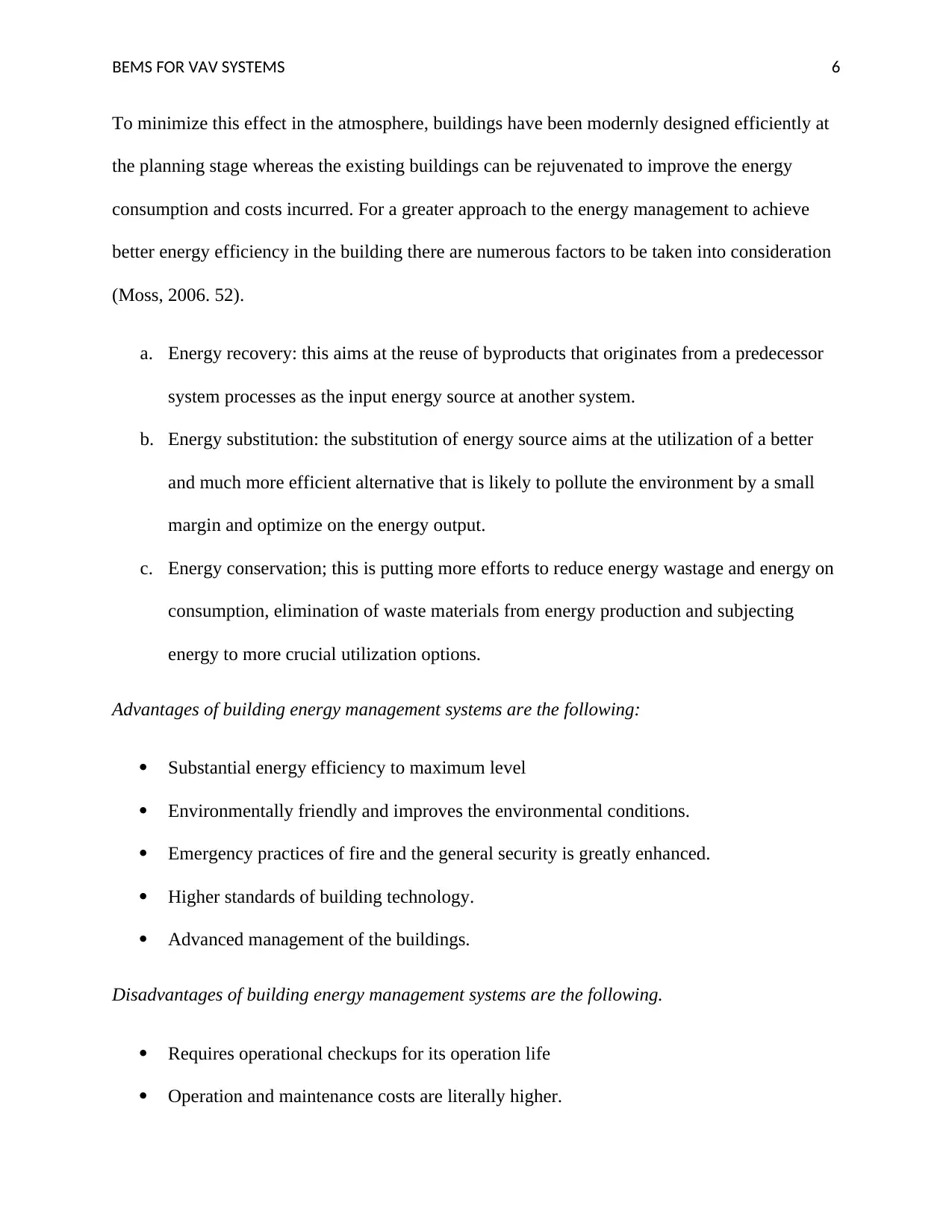
BEMS FOR VAV SYSTEMS 6
To minimize this effect in the atmosphere, buildings have been modernly designed efficiently at
the planning stage whereas the existing buildings can be rejuvenated to improve the energy
consumption and costs incurred. For a greater approach to the energy management to achieve
better energy efficiency in the building there are numerous factors to be taken into consideration
(Moss, 2006. 52).
a. Energy recovery: this aims at the reuse of byproducts that originates from a predecessor
system processes as the input energy source at another system.
b. Energy substitution: the substitution of energy source aims at the utilization of a better
and much more efficient alternative that is likely to pollute the environment by a small
margin and optimize on the energy output.
c. Energy conservation; this is putting more efforts to reduce energy wastage and energy on
consumption, elimination of waste materials from energy production and subjecting
energy to more crucial utilization options.
Advantages of building energy management systems are the following:
Substantial energy efficiency to maximum level
Environmentally friendly and improves the environmental conditions.
Emergency practices of fire and the general security is greatly enhanced.
Higher standards of building technology.
Advanced management of the buildings.
Disadvantages of building energy management systems are the following.
Requires operational checkups for its operation life
Operation and maintenance costs are literally higher.
To minimize this effect in the atmosphere, buildings have been modernly designed efficiently at
the planning stage whereas the existing buildings can be rejuvenated to improve the energy
consumption and costs incurred. For a greater approach to the energy management to achieve
better energy efficiency in the building there are numerous factors to be taken into consideration
(Moss, 2006. 52).
a. Energy recovery: this aims at the reuse of byproducts that originates from a predecessor
system processes as the input energy source at another system.
b. Energy substitution: the substitution of energy source aims at the utilization of a better
and much more efficient alternative that is likely to pollute the environment by a small
margin and optimize on the energy output.
c. Energy conservation; this is putting more efforts to reduce energy wastage and energy on
consumption, elimination of waste materials from energy production and subjecting
energy to more crucial utilization options.
Advantages of building energy management systems are the following:
Substantial energy efficiency to maximum level
Environmentally friendly and improves the environmental conditions.
Emergency practices of fire and the general security is greatly enhanced.
Higher standards of building technology.
Advanced management of the buildings.
Disadvantages of building energy management systems are the following.
Requires operational checkups for its operation life
Operation and maintenance costs are literally higher.
⊘ This is a preview!⊘
Do you want full access?
Subscribe today to unlock all pages.

Trusted by 1+ million students worldwide
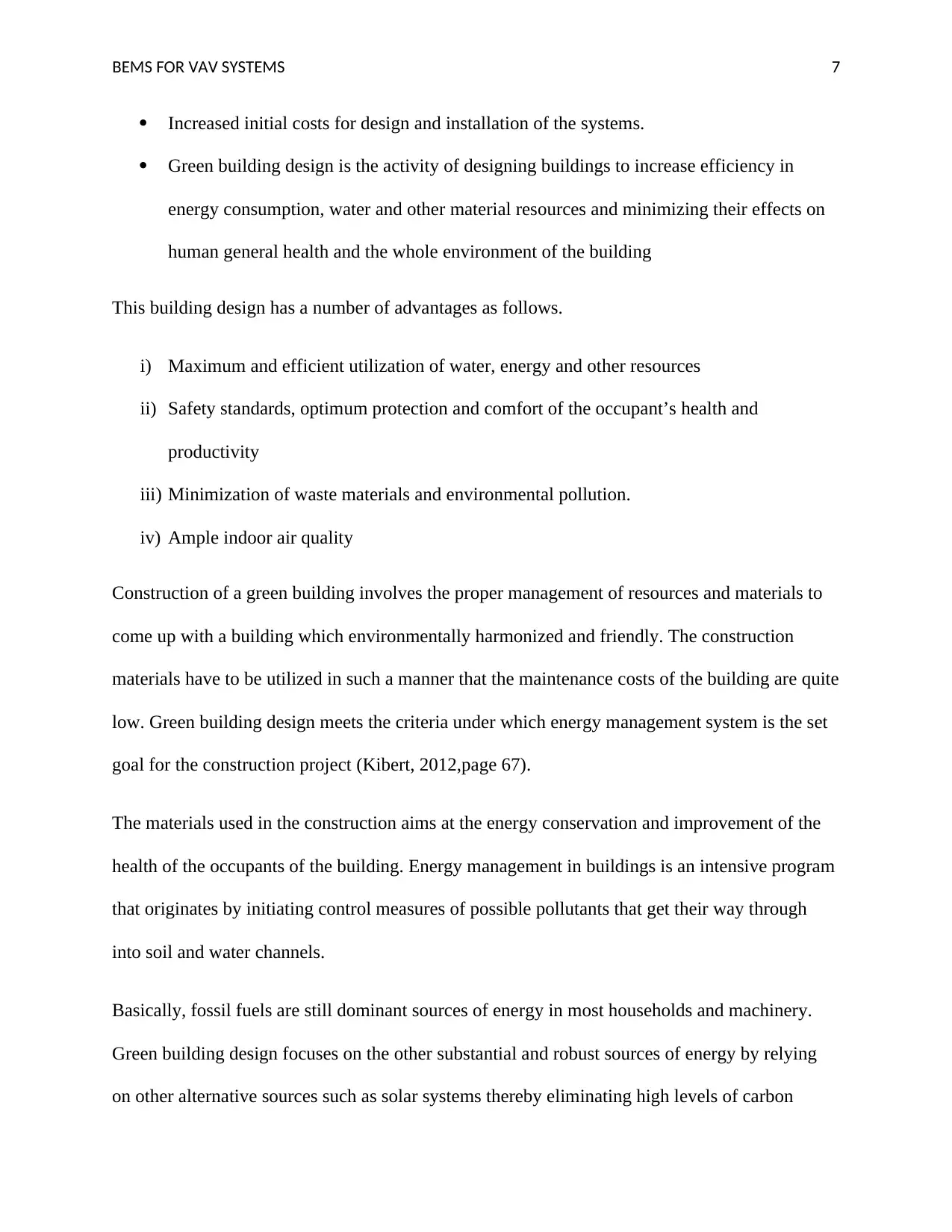
BEMS FOR VAV SYSTEMS 7
Increased initial costs for design and installation of the systems.
Green building design is the activity of designing buildings to increase efficiency in
energy consumption, water and other material resources and minimizing their effects on
human general health and the whole environment of the building
This building design has a number of advantages as follows.
i) Maximum and efficient utilization of water, energy and other resources
ii) Safety standards, optimum protection and comfort of the occupant’s health and
productivity
iii) Minimization of waste materials and environmental pollution.
iv) Ample indoor air quality
Construction of a green building involves the proper management of resources and materials to
come up with a building which environmentally harmonized and friendly. The construction
materials have to be utilized in such a manner that the maintenance costs of the building are quite
low. Green building design meets the criteria under which energy management system is the set
goal for the construction project (Kibert, 2012,page 67).
The materials used in the construction aims at the energy conservation and improvement of the
health of the occupants of the building. Energy management in buildings is an intensive program
that originates by initiating control measures of possible pollutants that get their way through
into soil and water channels.
Basically, fossil fuels are still dominant sources of energy in most households and machinery.
Green building design focuses on the other substantial and robust sources of energy by relying
on other alternative sources such as solar systems thereby eliminating high levels of carbon
Increased initial costs for design and installation of the systems.
Green building design is the activity of designing buildings to increase efficiency in
energy consumption, water and other material resources and minimizing their effects on
human general health and the whole environment of the building
This building design has a number of advantages as follows.
i) Maximum and efficient utilization of water, energy and other resources
ii) Safety standards, optimum protection and comfort of the occupant’s health and
productivity
iii) Minimization of waste materials and environmental pollution.
iv) Ample indoor air quality
Construction of a green building involves the proper management of resources and materials to
come up with a building which environmentally harmonized and friendly. The construction
materials have to be utilized in such a manner that the maintenance costs of the building are quite
low. Green building design meets the criteria under which energy management system is the set
goal for the construction project (Kibert, 2012,page 67).
The materials used in the construction aims at the energy conservation and improvement of the
health of the occupants of the building. Energy management in buildings is an intensive program
that originates by initiating control measures of possible pollutants that get their way through
into soil and water channels.
Basically, fossil fuels are still dominant sources of energy in most households and machinery.
Green building design focuses on the other substantial and robust sources of energy by relying
on other alternative sources such as solar systems thereby eliminating high levels of carbon
Paraphrase This Document
Need a fresh take? Get an instant paraphrase of this document with our AI Paraphraser
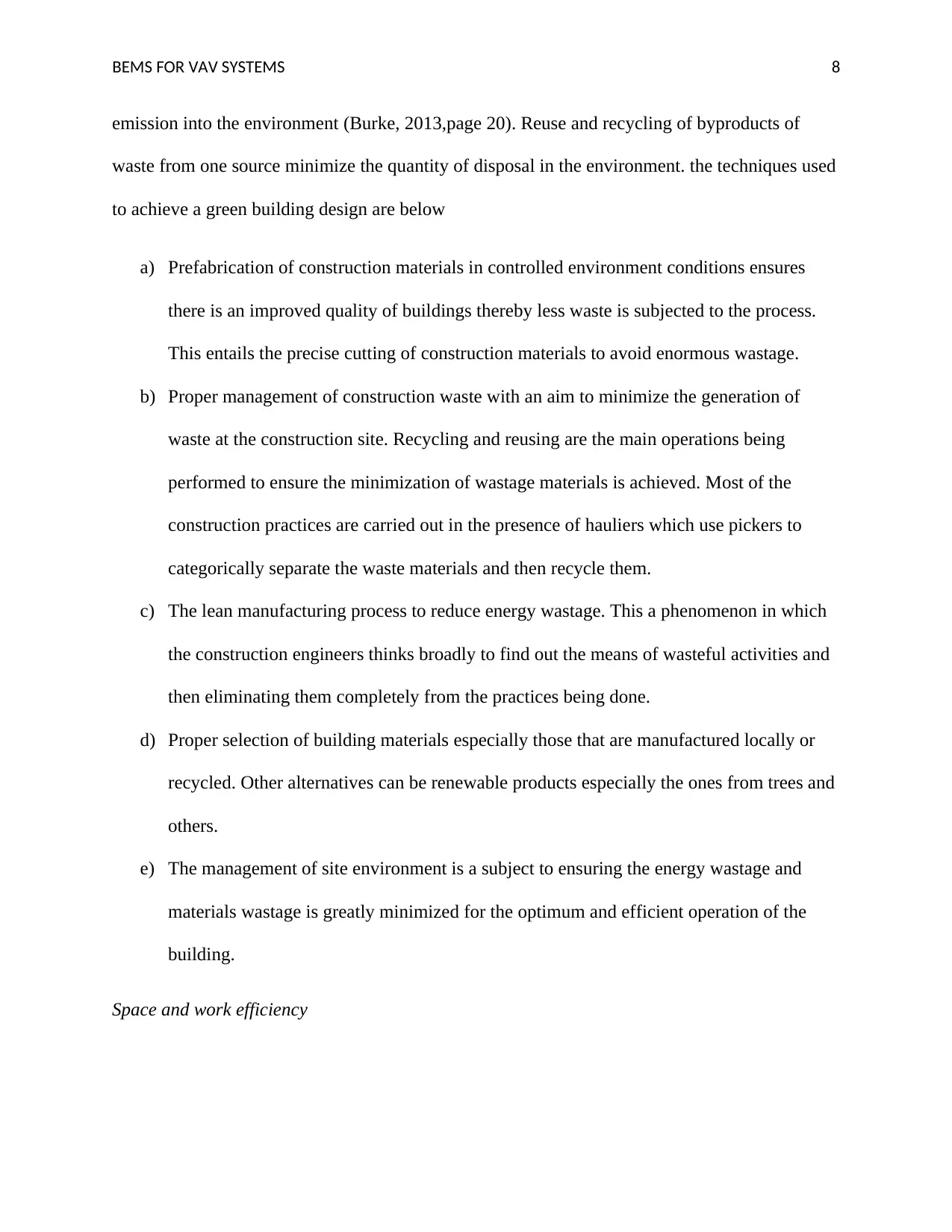
BEMS FOR VAV SYSTEMS 8
emission into the environment (Burke, 2013,page 20). Reuse and recycling of byproducts of
waste from one source minimize the quantity of disposal in the environment. the techniques used
to achieve a green building design are below
a) Prefabrication of construction materials in controlled environment conditions ensures
there is an improved quality of buildings thereby less waste is subjected to the process.
This entails the precise cutting of construction materials to avoid enormous wastage.
b) Proper management of construction waste with an aim to minimize the generation of
waste at the construction site. Recycling and reusing are the main operations being
performed to ensure the minimization of wastage materials is achieved. Most of the
construction practices are carried out in the presence of hauliers which use pickers to
categorically separate the waste materials and then recycle them.
c) The lean manufacturing process to reduce energy wastage. This a phenomenon in which
the construction engineers thinks broadly to find out the means of wasteful activities and
then eliminating them completely from the practices being done.
d) Proper selection of building materials especially those that are manufactured locally or
recycled. Other alternatives can be renewable products especially the ones from trees and
others.
e) The management of site environment is a subject to ensuring the energy wastage and
materials wastage is greatly minimized for the optimum and efficient operation of the
building.
Space and work efficiency
emission into the environment (Burke, 2013,page 20). Reuse and recycling of byproducts of
waste from one source minimize the quantity of disposal in the environment. the techniques used
to achieve a green building design are below
a) Prefabrication of construction materials in controlled environment conditions ensures
there is an improved quality of buildings thereby less waste is subjected to the process.
This entails the precise cutting of construction materials to avoid enormous wastage.
b) Proper management of construction waste with an aim to minimize the generation of
waste at the construction site. Recycling and reusing are the main operations being
performed to ensure the minimization of wastage materials is achieved. Most of the
construction practices are carried out in the presence of hauliers which use pickers to
categorically separate the waste materials and then recycle them.
c) The lean manufacturing process to reduce energy wastage. This a phenomenon in which
the construction engineers thinks broadly to find out the means of wasteful activities and
then eliminating them completely from the practices being done.
d) Proper selection of building materials especially those that are manufactured locally or
recycled. Other alternatives can be renewable products especially the ones from trees and
others.
e) The management of site environment is a subject to ensuring the energy wastage and
materials wastage is greatly minimized for the optimum and efficient operation of the
building.
Space and work efficiency
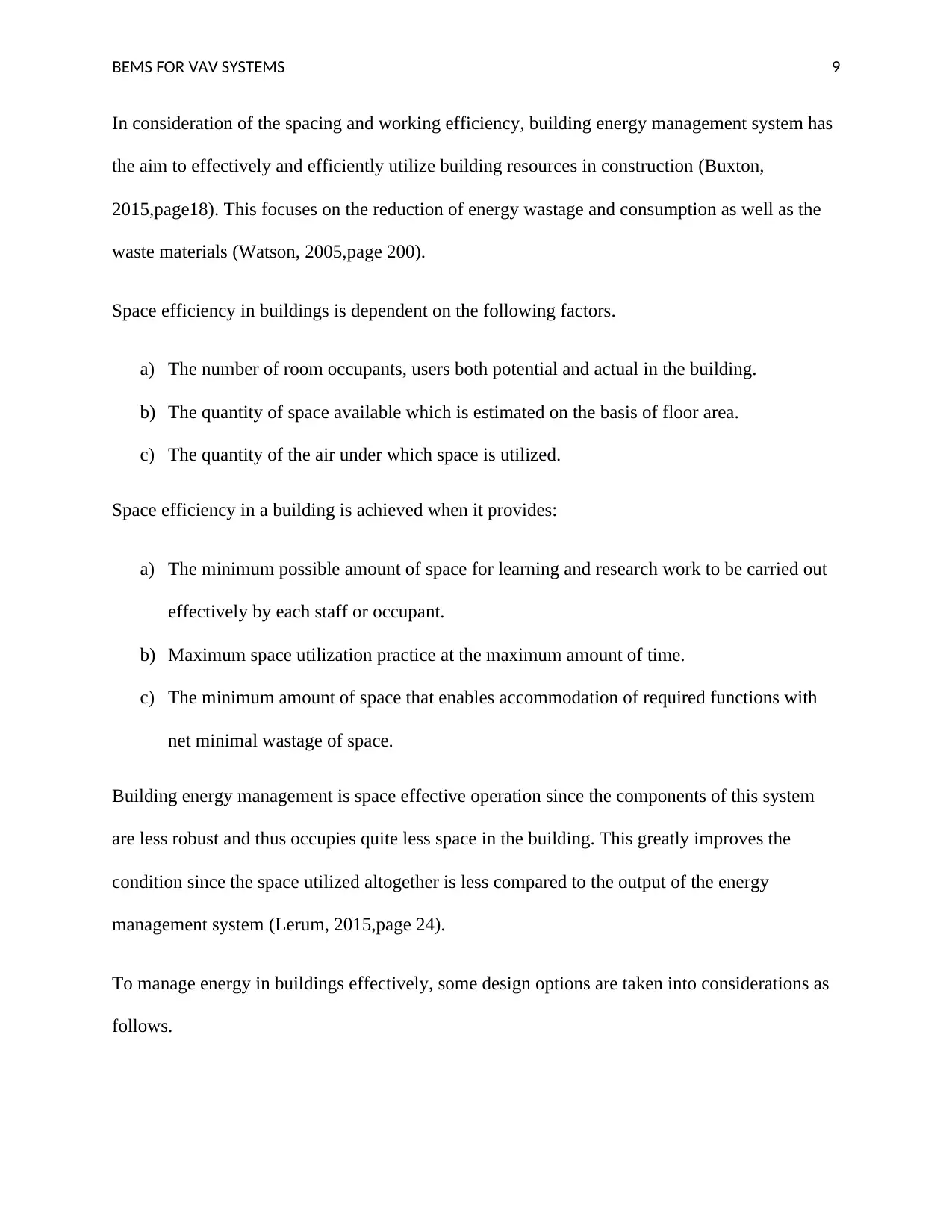
BEMS FOR VAV SYSTEMS 9
In consideration of the spacing and working efficiency, building energy management system has
the aim to effectively and efficiently utilize building resources in construction (Buxton,
2015,page18). This focuses on the reduction of energy wastage and consumption as well as the
waste materials (Watson, 2005,page 200).
Space efficiency in buildings is dependent on the following factors.
a) The number of room occupants, users both potential and actual in the building.
b) The quantity of space available which is estimated on the basis of floor area.
c) The quantity of the air under which space is utilized.
Space efficiency in a building is achieved when it provides:
a) The minimum possible amount of space for learning and research work to be carried out
effectively by each staff or occupant.
b) Maximum space utilization practice at the maximum amount of time.
c) The minimum amount of space that enables accommodation of required functions with
net minimal wastage of space.
Building energy management is space effective operation since the components of this system
are less robust and thus occupies quite less space in the building. This greatly improves the
condition since the space utilized altogether is less compared to the output of the energy
management system (Lerum, 2015,page 24).
To manage energy in buildings effectively, some design options are taken into considerations as
follows.
In consideration of the spacing and working efficiency, building energy management system has
the aim to effectively and efficiently utilize building resources in construction (Buxton,
2015,page18). This focuses on the reduction of energy wastage and consumption as well as the
waste materials (Watson, 2005,page 200).
Space efficiency in buildings is dependent on the following factors.
a) The number of room occupants, users both potential and actual in the building.
b) The quantity of space available which is estimated on the basis of floor area.
c) The quantity of the air under which space is utilized.
Space efficiency in a building is achieved when it provides:
a) The minimum possible amount of space for learning and research work to be carried out
effectively by each staff or occupant.
b) Maximum space utilization practice at the maximum amount of time.
c) The minimum amount of space that enables accommodation of required functions with
net minimal wastage of space.
Building energy management is space effective operation since the components of this system
are less robust and thus occupies quite less space in the building. This greatly improves the
condition since the space utilized altogether is less compared to the output of the energy
management system (Lerum, 2015,page 24).
To manage energy in buildings effectively, some design options are taken into considerations as
follows.
⊘ This is a preview!⊘
Do you want full access?
Subscribe today to unlock all pages.

Trusted by 1+ million students worldwide
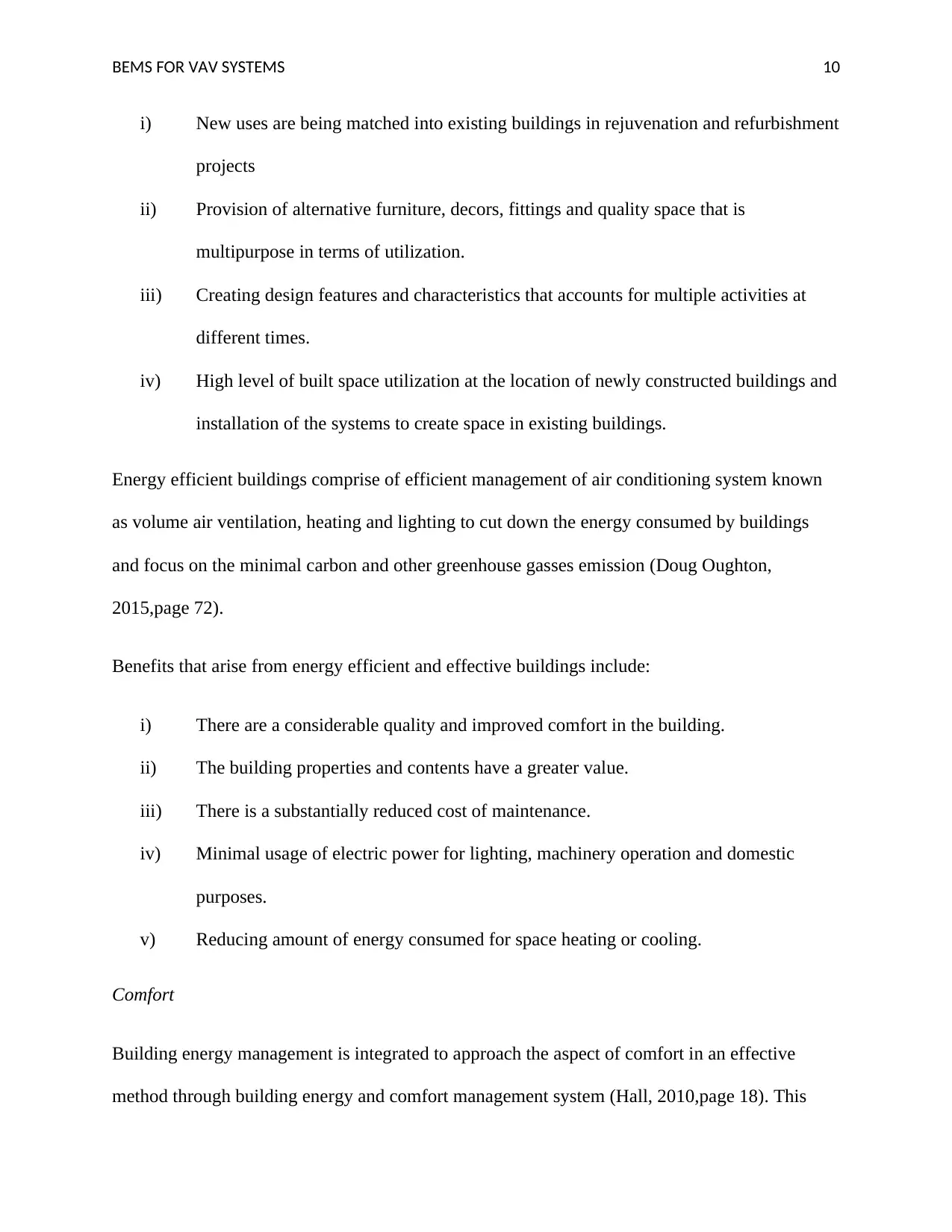
BEMS FOR VAV SYSTEMS 10
i) New uses are being matched into existing buildings in rejuvenation and refurbishment
projects
ii) Provision of alternative furniture, decors, fittings and quality space that is
multipurpose in terms of utilization.
iii) Creating design features and characteristics that accounts for multiple activities at
different times.
iv) High level of built space utilization at the location of newly constructed buildings and
installation of the systems to create space in existing buildings.
Energy efficient buildings comprise of efficient management of air conditioning system known
as volume air ventilation, heating and lighting to cut down the energy consumed by buildings
and focus on the minimal carbon and other greenhouse gasses emission (Doug Oughton,
2015,page 72).
Benefits that arise from energy efficient and effective buildings include:
i) There are a considerable quality and improved comfort in the building.
ii) The building properties and contents have a greater value.
iii) There is a substantially reduced cost of maintenance.
iv) Minimal usage of electric power for lighting, machinery operation and domestic
purposes.
v) Reducing amount of energy consumed for space heating or cooling.
Comfort
Building energy management is integrated to approach the aspect of comfort in an effective
method through building energy and comfort management system (Hall, 2010,page 18). This
i) New uses are being matched into existing buildings in rejuvenation and refurbishment
projects
ii) Provision of alternative furniture, decors, fittings and quality space that is
multipurpose in terms of utilization.
iii) Creating design features and characteristics that accounts for multiple activities at
different times.
iv) High level of built space utilization at the location of newly constructed buildings and
installation of the systems to create space in existing buildings.
Energy efficient buildings comprise of efficient management of air conditioning system known
as volume air ventilation, heating and lighting to cut down the energy consumed by buildings
and focus on the minimal carbon and other greenhouse gasses emission (Doug Oughton,
2015,page 72).
Benefits that arise from energy efficient and effective buildings include:
i) There are a considerable quality and improved comfort in the building.
ii) The building properties and contents have a greater value.
iii) There is a substantially reduced cost of maintenance.
iv) Minimal usage of electric power for lighting, machinery operation and domestic
purposes.
v) Reducing amount of energy consumed for space heating or cooling.
Comfort
Building energy management is integrated to approach the aspect of comfort in an effective
method through building energy and comfort management system (Hall, 2010,page 18). This
Paraphrase This Document
Need a fresh take? Get an instant paraphrase of this document with our AI Paraphraser
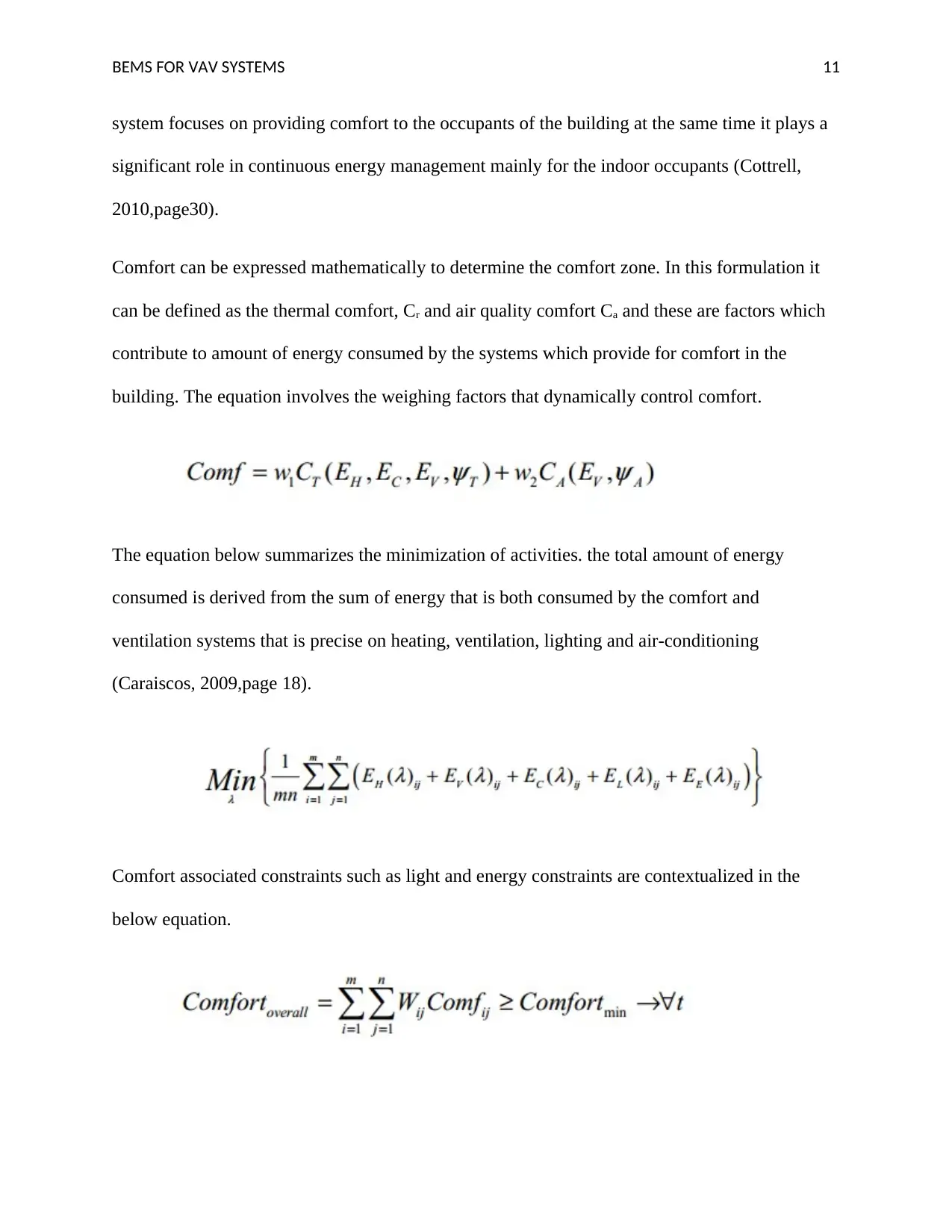
BEMS FOR VAV SYSTEMS 11
system focuses on providing comfort to the occupants of the building at the same time it plays a
significant role in continuous energy management mainly for the indoor occupants (Cottrell,
2010,page30).
Comfort can be expressed mathematically to determine the comfort zone. In this formulation it
can be defined as the thermal comfort, Cr and air quality comfort Ca and these are factors which
contribute to amount of energy consumed by the systems which provide for comfort in the
building. The equation involves the weighing factors that dynamically control comfort.
The equation below summarizes the minimization of activities. the total amount of energy
consumed is derived from the sum of energy that is both consumed by the comfort and
ventilation systems that is precise on heating, ventilation, lighting and air-conditioning
(Caraiscos, 2009,page 18).
Comfort associated constraints such as light and energy constraints are contextualized in the
below equation.
system focuses on providing comfort to the occupants of the building at the same time it plays a
significant role in continuous energy management mainly for the indoor occupants (Cottrell,
2010,page30).
Comfort can be expressed mathematically to determine the comfort zone. In this formulation it
can be defined as the thermal comfort, Cr and air quality comfort Ca and these are factors which
contribute to amount of energy consumed by the systems which provide for comfort in the
building. The equation involves the weighing factors that dynamically control comfort.
The equation below summarizes the minimization of activities. the total amount of energy
consumed is derived from the sum of energy that is both consumed by the comfort and
ventilation systems that is precise on heating, ventilation, lighting and air-conditioning
(Caraiscos, 2009,page 18).
Comfort associated constraints such as light and energy constraints are contextualized in the
below equation.
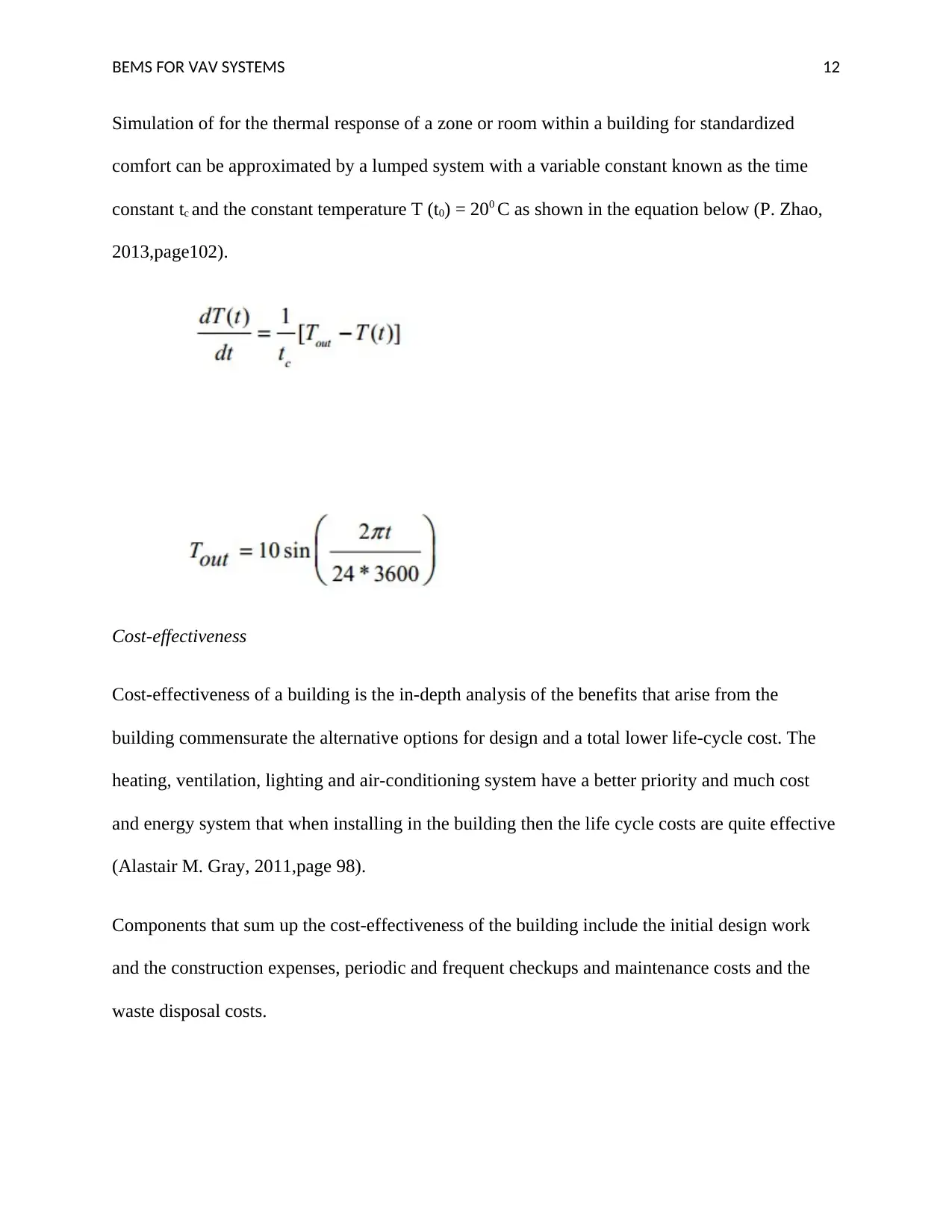
BEMS FOR VAV SYSTEMS 12
Simulation of for the thermal response of a zone or room within a building for standardized
comfort can be approximated by a lumped system with a variable constant known as the time
constant tc and the constant temperature T (t0) = 200 C as shown in the equation below (P. Zhao,
2013,page102).
Cost-effectiveness
Cost-effectiveness of a building is the in-depth analysis of the benefits that arise from the
building commensurate the alternative options for design and a total lower life-cycle cost. The
heating, ventilation, lighting and air-conditioning system have a better priority and much cost
and energy system that when installing in the building then the life cycle costs are quite effective
(Alastair M. Gray, 2011,page 98).
Components that sum up the cost-effectiveness of the building include the initial design work
and the construction expenses, periodic and frequent checkups and maintenance costs and the
waste disposal costs.
Simulation of for the thermal response of a zone or room within a building for standardized
comfort can be approximated by a lumped system with a variable constant known as the time
constant tc and the constant temperature T (t0) = 200 C as shown in the equation below (P. Zhao,
2013,page102).
Cost-effectiveness
Cost-effectiveness of a building is the in-depth analysis of the benefits that arise from the
building commensurate the alternative options for design and a total lower life-cycle cost. The
heating, ventilation, lighting and air-conditioning system have a better priority and much cost
and energy system that when installing in the building then the life cycle costs are quite effective
(Alastair M. Gray, 2011,page 98).
Components that sum up the cost-effectiveness of the building include the initial design work
and the construction expenses, periodic and frequent checkups and maintenance costs and the
waste disposal costs.
⊘ This is a preview!⊘
Do you want full access?
Subscribe today to unlock all pages.

Trusted by 1+ million students worldwide
1 out of 24
Related Documents
Your All-in-One AI-Powered Toolkit for Academic Success.
+13062052269
info@desklib.com
Available 24*7 on WhatsApp / Email
![[object Object]](/_next/static/media/star-bottom.7253800d.svg)
Unlock your academic potential
Copyright © 2020–2025 A2Z Services. All Rights Reserved. Developed and managed by ZUCOL.





